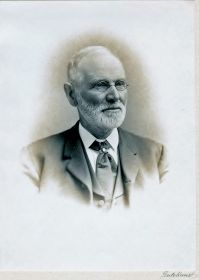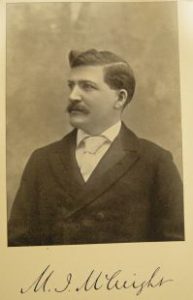1812 — George Shaffer is DuBois’ First Permanent Inhabitant
George Shaffer and wife, with their six children, Frederick, Michael, George, Jr., and three daughters, migrated from Dauphin County, Pa., in 1812 to where DuBois now stands. On May 13, 1812, a part of the family arrived and erected a ” bark shanty.” On the night of May 14, Frederick and Michael Shaffer slept in this shanty, which they erected in what is now the First Ward of the city, the other members of the family stopping with Jacob Ogden, a pioneer who lived at what was Carlisle Station on the Buffalo, Rochester, and Pittsburgh railway, south of DuBois.
The Shaffer’s cleared two acres of land on the ridge or hillside in that year. Charles C. Gaskell was agent for the land, and George Shaffer, Jr., afterwards bought the land from him. The Shaffer property passed from their hands in 1853 to Jacob Heberling, who sold to his son, David, who owned and occupied the land until 1865, when he sold the 250 acres of it to John Rumbarger.
Much of George’s original acreage was passed along to his grandson, Henry. He did not value the land, finding what would be central DuBois to be low and swampy and began to sell it off in one-acre parcels. The owners were left to determine their own roads resulting in the narrow streets in DuBois today.
Henry eventually sold all of his land and moved to Lawrence Township near Clearfield to escape the growing population.
John Rumbarger, An Early Settler
 John Rumbarger Jr. established the town of Rumbarger, the precursor of the present City of DuBois. He was born in Warrior’s Mark, Huntingdon County, Pa, May 25, 1810. In 1850, he left Huntingdon County and moved first to Kittanning, Pa., then Black Fox Furnace, near Parker’s Landing, Pa., and finally to Brookville, Pa., where he worked as a lumberman until the end of the Civil War.
John Rumbarger Jr. established the town of Rumbarger, the precursor of the present City of DuBois. He was born in Warrior’s Mark, Huntingdon County, Pa, May 25, 1810. In 1850, he left Huntingdon County and moved first to Kittanning, Pa., then Black Fox Furnace, near Parker’s Landing, Pa., and finally to Brookville, Pa., where he worked as a lumberman until the end of the Civil War.
In 1865, Rumbarger bought from David Heberling 325 acres in the wilderness of Brady Township. The greater portion of this land was within what is now the DuBois City Limits.
The natural growth of, the community and the prospects induced Rumbarger in 1872 to plot a portion of his farm in lots becoming the new town of Rumbarger. The growth of Rumbarger began to make rapid progress,
John DuBois first visited the area now occupied by Rumbarger in 1842, meeting George Shaffer. When DuBois returned in 1871 to develop the property, he had purchased he found Rumbarger living in the now deceased Shaffer’s home.
The arrival of John DuBois and his lumber mills brought a desire to change the name of the community from Rumbarger to DuBois. A compromise was reached, and the town became DuBois permanently.
Rumbarger, seeing that DuBois was going to be establishing business and bringing in a large potential for different types of work, started to sell off the lots on the land he owned.
That land is the original DuBois area itself and the town of DuBois. George Kirk surveyed the lots around the area and the lots on his land and put advertisements in the Clarion and Brookville newspapers to get potential buyers to come look at those lots.
Rumbarger described the town as beautifully situated on Sandy Creek within 80 rods of the railroad nearing completion and on a public road leading from Luthersburg to Brockwayville. He described the large steam sawmill and general lumber establishment, under construction by a John DuBois, that would give employment to not less than 100 hands.
Rumbarger was active in business until approximately 1879. He was married twice and had 13 children. He died in 1889.
1872-84 — John DuBois Opens Several Mills
 John DuBois’ first property development in what is now DuBois came in 1872. It was a wood mill with a smaller mill. He started the big mill, or the loggers’ mill, in the area of what is now Liberty Boulevard in 1873.
John DuBois’ first property development in what is now DuBois came in 1872. It was a wood mill with a smaller mill. He started the big mill, or the loggers’ mill, in the area of what is now Liberty Boulevard in 1873.
He built a box factory in 1881 that manufactured shirt cases and tobacco cases, as well as siding and flooring. He brought the iron works that was in Williamsport to DuBois and set that up in production in 1875.
He started the Hemlock Mill in 1884, and manufactured hemlock lumber as well as some hardwood lumber. He needed a market for the hemlock bark, so in 1883 John and two of the Van Tassel brothers started a firm for the tanning of leather and built a large tannery where the Third Ward Hose House now stands. That entire area was given to the city for public use in the later 1800s or early 1900s, following John DuBois’ death in 1886.
John E. DuBois
John E. DuBois was born at Tioga Center, New York, on May 15, 1861, to Ezekiel DuBois and Clarissa Badger.
He came to DuBois in 1863 to work with his uncle, John DuBois in his uncle’s lumber business. John E. learned the lumber business from the entry level. By 1885 his uncle had six major contractors of DuBois cutting timber on his lands with four of them constructing their own small lumber railroads. Two lumber railroads associated with the DuBois name were the early Clear Run and the later Juniata Railroad.
of DuBois cutting timber on his lands with four of them constructing their own small lumber railroads. Two lumber railroads associated with the DuBois name were the early Clear Run and the later Juniata Railroad.
Upon the death of his uncle in 1886, John E., then 25 years old, assumed operation of his uncle’s businesses—logging, lumber mills, iron works, box factory, and tannery. He attempted to extend the Juniata Railroad from DuBois to Kersey but failed due to the price of land along the right-of-way.
John E. married Willie Gamble on September 15, 1897. They had five children: John, Lewis, Caroline, David, and Sarah.
He died in DuBois on November 11, 1934, and is interred at Morningside Cemetery in DuBois. His wife Willie died in 1935.
Major M. I. McCreight
 Major M. I. McCreight was one of the most colorful characters in DuBois’ 125-year history.
Major M. I. McCreight was one of the most colorful characters in DuBois’ 125-year history.
Born near Reynoldsville in 1865, he was out of the same mold as President Theodore Roosevelt. He received his early education in country skills and went to Eastman Business School in Poughkeepsie, N.Y., at age 16, graduating four years later. After a brief time as a storekeeper and banker in Reynoldsville he went to the Dakota territory working as a cattle dealer.
There McCreight had many encounters with Native Americans and plains legends such as Buffalo Bill Cody, who came to visit him as his home, the Wigwam, in DuBois after he returned in 1886. Becoming associated with the First National Bank he became manager of DuBois Deposit Bank after it was purchased. He lived until age 93 and maintained his continuing interest in the DuBois community including authoring a book of DuBois history.

